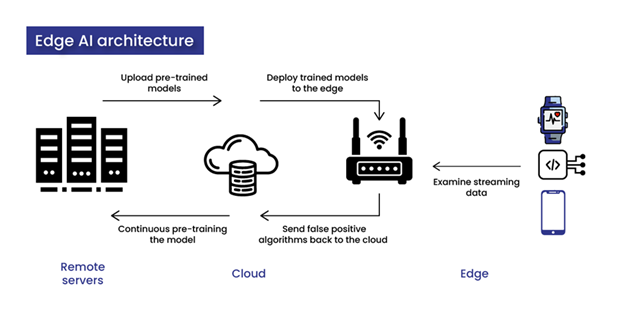In an era where the presence of AI is growing at an accelerated rate, the fusion of its capabilities with edge computing cannot be ignored. As AI continues to transform industries, the flexibility of edge computing becomes increasingly vital.
As data volumes increase exponentially and devices become more connected, traditional cloud computing models are barely able to keep up. Issues such as high latency, limited bandwidth, and data privacy have made organizations rethink their current data processing practices. This is where Edge AI solutions come in. By combining artificial intelligence (AI) with edge computing, analytics can be moved to the source—local devices like sensors, gateways, or embedded systems. The result is real-time AI processing, quicker response times, and decreased dependence on cloud resources.
In fact, in the digital era, almost every business contains job functions that can immensely benefit from adopting Edge AI. Now that we have a fair idea about this booming technology, let’s take a deeper look at it in this blog.
Why Edge AI is Gaining Momentum in Modern Enterprises
The report by Grand View Research states that the global Edge AI market is projected to grow at a compound annual Growth Rate (CAGR) of 21.0% by 2030.
These numbers signal the increasing trend of Edge AI in the market, making it difficult to overlook the potential of AI, edge computing, and the proliferation of IoT devices that together can help unlock the power of Edge AI.
Some of the most persistent challenges in data processing can be solved by Edge AI technology. In a real-world setting, many industries that require quick decision-making and responsiveness cannot wait for data to travel to the cloud and back. The answer is to move AI capabilities to the edge, closer to where data is generated. This enables organizations to unlock insights faster, improve operational efficiency, and reduce their reliance on centralized cloud infrastructures.
Take the example of a healthcare facility where AI-powered edge devices monitor patient vitals in real time and send alerts within milliseconds. And because data is processed locally, it also addresses privacy and compliance concerns. With Edge AI, raw data stays on-site—offering greater control and helping organizations meet data sovereignty regulations.
Real-World Applications of Edge AI and Edge Computing
Edge AI applications are delivering value across a wide range of industries:
- Retail analytics: AI-powered cameras monitor foot traffic, detect long checkout lines, and alert staff to restock items. Check out our latest article Retail Store Analytics
- Autonomous vehicles: Edge AI handles real-time decision-making to avoid obstacles and adjust routes based on road conditions.
- Industrial IoT and manufacturing: Monitors machinery and environmental conditions, enabling predictive maintenance and workplace safety.
- Smart agriculture: Sensors analyze soil health, detect pests, and optimize irrigation.
All these examples require low latency AI, reduced network dependence, and access to real-time data—capabilities that Edge AI delivers efficiently. Discover the top AI trends on emerging technologies, use cases, and strategies redefining business advantage
Download Top AI trends
How Edge AI Works in Practice
Several components work together seamlessly to enable Edge AI deployments as shown in the image below:
- Local data sources: Sensors, cameras, microphones, and machines collect information.
- On-device AI processing: Specialized models run directly on edge devices, bypassing the need for cloud-based analysis.
- Optimized AI models: Quantization, pruning, and other AI model optimization techniques reduce computational load.
- Edge hardware: Devices like NVIDIA Jetson, Qualcomm AI chips, or microcontrollers run lightweight models efficiently.
- Operational insights: Local processing enables actionable alerts, summaries, or metrics for further cloud-based analytics when needed.
How Calsoft Supports Edge AI Integration
Implementing Edge AI requires more than technical tools—it needs deep domain and deployment expertise. Whether you are optimizing AI models or building robust edge infrastructures, Calsoft brings a combination of engineering skill and domain experience. Our aim is to help organizations deploy intelligent edge systems that operate reliably under real-world conditions.
Get more insights on how Edge capabilities redefine retail operations with better data processing, faster turnaround time, smoother cloud-based mobility and more.
Challenges in Deploying AI at the Edge
While AI at the edge offers clear benefits, it also comes with challenges:
- Hardware limitations: Requires lightweight models optimized for memory and computing.
- Connectivity constraints: Devices may be in rugged or remote environments with limited internet access.
- Model lifecycle management: Updating AI models across thousands of devices demands remote monitoring and OTA (over-the-air) updates.
- Security concerns: Protecting both data and models on edge devices requires robust encryption, secure boot mechanisms, and hardware-level security features.
How to Get Started with Edge AI for Your Business
To deploy Edge AI effectively, organizations should:
- Identify high-impact, real-time use cases (e.g., downtime reduction, safety, customer experience).
- Choose the right edge computing hardware with optimal performance and power balance.
- Develop edge-optimized AI models and use proper tooling for monitoring, performance tracking, and updates.
- Prioritize edge device security, covering both communication channels and the AI models in use.
Edge AI adoption is accelerating with trends like federated learning, which enables private, on-device model training; TinyML, bringing machine learning to low-power microcontrollers for smart IoT and remote monitoring; and unified AI management platforms that streamline model deployment and orchestration across cloud, edge, and endpoint environments.
Final Thoughts: Why Edge AI Matters
Edge AI technology is reshaping how businesses handle data. By processing data where it’s generated, it reduces latency, enhances security, and lowers operational costs. As industries move toward decentralized, data-intensive ecosystems, Edge AI will be critical to keeping systems resilient, responsive, and scalable.
FAQ’s
Q1: What is Edge AI and how is it different from cloud AI?
A. Edge AI runs AI models on local devices, enabling real-time processing without sending data to the cloud—unlike cloud AI, which relies on centralized servers.
Q2: What are the key benefits of Edge AI?
A. It reduces latency, enhances data privacy, lowers bandwidth use, and enables faster decision-making close to the data source.
Q3: How can businesses start with Edge AI solutions?
A. Begin with real-time use cases, choose the right edge hardware, optimize models for local deployment, and ensure secure device management.
The post Edge AI Solutions: Combining Edge Computing and Artificial Intelligence for Real-Time Processing appeared first on Calsoft Blog.


